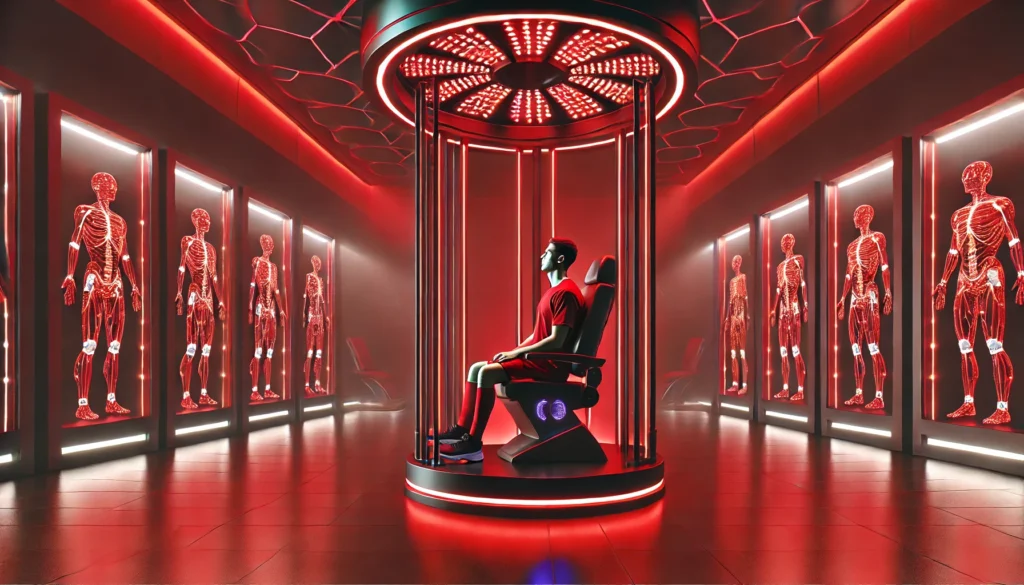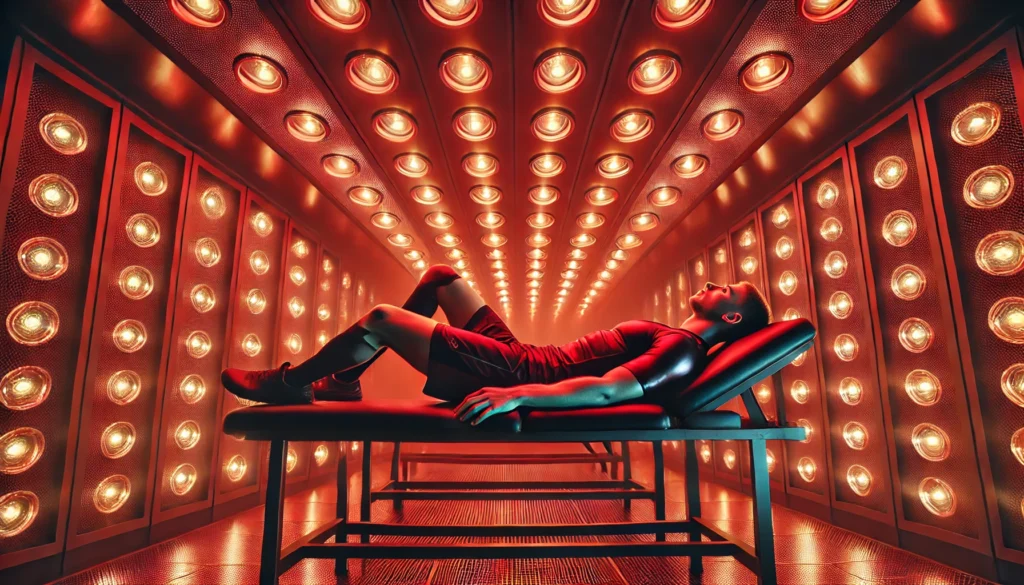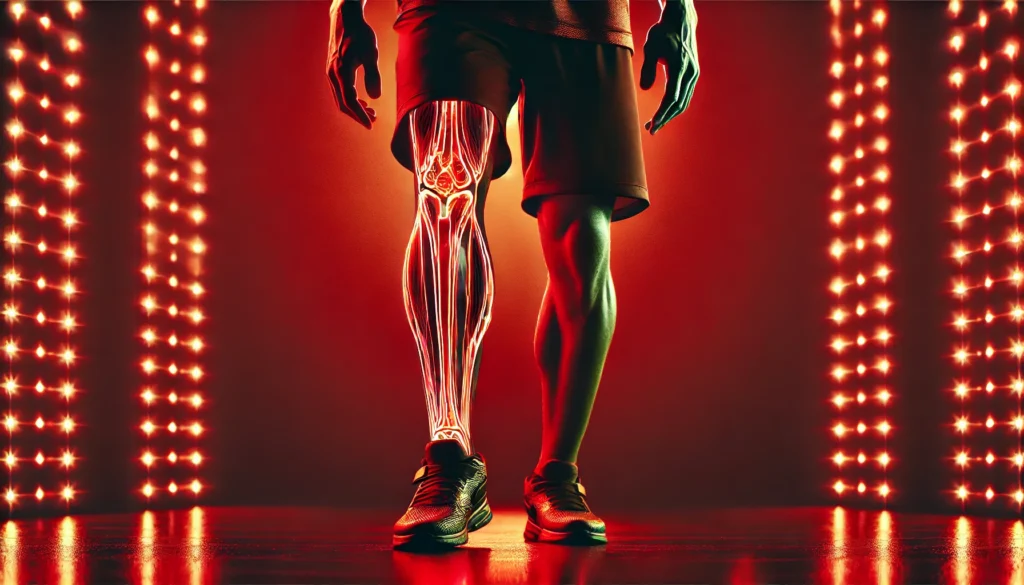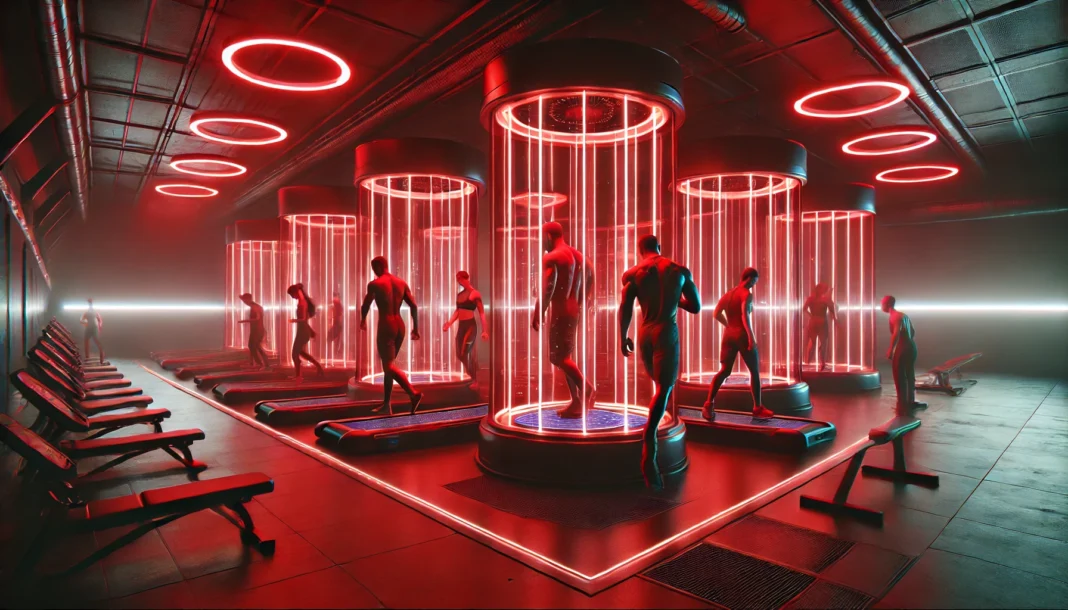Introduction
Athletes are constantly searching for effective ways to improve performance, speed recovery, and reduce pain associated with intense physical activity. One increasingly popular method that has gained traction in sports medicine is red light therapy for muscle recovery. This non-invasive, science-backed approach harnesses the power of red and near-infrared light to stimulate cellular processes that aid in muscle repair, reduce inflammation, and alleviate pain. Understanding the mechanisms behind red light therapy and how it benefits athletic recovery can provide a competitive edge and improve overall well-being.
You may also like: 5 Key Herbs for Prostate Health: Transforming Men’s Wellness Naturally
The therapeutic application of light, particularly red light therapy for injuries, has been the subject of extensive research. Many studies confirm its effectiveness in reducing muscle soreness, accelerating tissue repair, and improving blood circulation. Unlike traditional recovery methods, such as ice baths or compression therapy, red light therapy works at a cellular level, promoting mitochondrial activity and enhancing ATP production. This increased energy output helps cells function more efficiently, leading to faster recovery times and reduced muscle fatigue.
As red light therapy for athletes continues to gain recognition, professional and amateur athletes alike are incorporating it into their recovery routines. From reducing post-workout soreness to mitigating chronic pain conditions like arthritis, the benefits of this cutting-edge therapy extend far beyond immediate muscle repair. In this article, we will explore the science behind red light therapy, its effectiveness for muscle pain and injuries, and practical applications for athletes looking to optimize their performance and recovery.
The Science Behind Red Light Therapy for Muscle Recovery
Red light therapy works by delivering specific wavelengths of light—typically between 600 and 1,000 nanometers—directly into the skin and deep tissues. This light is absorbed by the mitochondria within cells, stimulating the production of adenosine triphosphate (ATP), which serves as the primary energy source for cellular functions. Increased ATP production allows cells to repair themselves more efficiently, reducing muscle damage and inflammation while promoting overall recovery.
One of the primary mechanisms of red light therapy for muscle recovery is its ability to reduce oxidative stress and inflammation. After intense exercise, the body experiences microtears in muscle fibers, which can lead to soreness and stiffness. Red light therapy counteracts these effects by increasing antioxidant activity and reducing pro-inflammatory cytokines, effectively minimizing delayed onset muscle soreness (DOMS) and promoting faster healing.
Additionally, red light therapy improves blood circulation, delivering more oxygen and nutrients to muscle tissues. Enhanced circulation accelerates the removal of metabolic waste products, such as lactic acid, that contribute to muscle fatigue. This increased blood flow also supports the formation of new capillaries, further improving the body’s ability to transport essential nutrients for tissue repair.
Athletes who incorporate red light therapy for sore muscles into their recovery regimen often report noticeable improvements in flexibility, reduced stiffness, and enhanced endurance. Unlike other treatments that merely mask pain, red light therapy addresses the root causes of muscle soreness and injury, making it a powerful tool for long-term athletic performance enhancement.

Red Light Therapy for Pain Management and Injury Recovery
For athletes dealing with chronic pain or sports injuries, red light therapy offers a promising solution. Conditions such as tendonitis, muscle strains, and ligament injuries can significantly hinder performance and prolong recovery periods. By stimulating cellular regeneration and reducing inflammation, red light therapy provides a non-invasive alternative to pain medications and invasive procedures.
One of the most common uses of red light therapy for pain is in the treatment of arthritis. Many athletes, especially those involved in high-impact sports, experience joint pain and stiffness due to repetitive stress on their joints. Studies have shown that red light treatment for arthritis helps reduce joint inflammation and improve mobility by stimulating collagen production and cartilage repair.
Similarly, red light therapy for muscle injury has been proven effective in expediting the healing process. Athletes recovering from sprains, tears, or overuse injuries benefit from consistent red light exposure, which enhances the body’s natural repair mechanisms. Unlike traditional pain relief methods such as nonsteroidal anti-inflammatory drugs (NSAIDs), red light therapy does not have adverse side effects and promotes healing rather than merely masking discomfort.
The use of red light therapy for sports injuries has gained attention among professional trainers, physical therapists, and sports medicine specialists. By integrating this therapy into rehabilitation programs, athletes can experience quicker recovery times, reduced reliance on medications, and a lower risk of re-injury.
How Red Light Therapy Benefits Athletes Post-Workout
Post-exercise recovery is a crucial component of athletic performance. Many athletes experience muscle fatigue, soreness, and stiffness following intense training sessions. Red light therapy after a workout helps mitigate these effects by accelerating the muscle repair process and reducing inflammation.
One key advantage of red light therapy for muscle pain is its ability to enhance muscle endurance and strength over time. By improving mitochondrial function, red light therapy enables muscle cells to produce more energy, leading to increased resilience and reduced susceptibility to fatigue. This can be particularly beneficial for endurance athletes, such as marathon runners or cyclists, who need sustained energy output for prolonged periods.
Furthermore, red light therapy for sore muscles aids in reducing oxidative stress, which is a major contributor to muscle damage and aging. The therapy’s ability to modulate reactive oxygen species (ROS) helps maintain cellular integrity and prevents long-term deterioration of muscle tissues. This means that athletes who regularly use red light therapy can maintain peak performance levels for longer periods without experiencing a decline in physical capability.
Beyond muscle recovery, red light therapy offers psychological benefits by reducing stress and improving sleep quality. Proper rest is essential for athletic recovery, and red light therapy has been found to regulate melatonin production, promoting deeper and more restorative sleep. This holistic approach to recovery ensures that athletes not only recover faster but also feel more rejuvenated and mentally prepared for their next training session.
The Role of Red Light Therapy in Preventing Injuries
In addition to speeding up recovery, red light therapy plays a vital role in injury prevention. By strengthening muscle fibers, reducing inflammation, and improving circulation, it helps athletes maintain peak performance while minimizing the risk of strains and overuse injuries. Regular use of red light therapy supports joint health, making it particularly beneficial for athletes engaging in high-impact sports.
Integrating Red Light Therapy into an Athlete’s Routine
To maximize the benefits of red light therapy, athletes should incorporate it strategically into their training and recovery schedules. Using red light therapy before a workout can enhance circulation and muscle activation, while post-workout application aids in reducing soreness and accelerating muscle repair. Combining red light therapy with other recovery techniques, such as stretching, hydration, and proper nutrition, can further enhance its effectiveness.
Frequently Asked Questions (FAQ) on Red Light Therapy for Muscle Recovery and Athletic Performance
1. How does red light therapy recovery compare to traditional recovery methods like ice baths and massage?
Red light therapy recovery offers unique benefits that traditional methods like ice baths and massage do not. While ice baths are effective in reducing inflammation by constricting blood vessels and numbing sore muscles, they do not actively promote cellular repair. Massage therapy helps with muscle relaxation and circulation, but it does not penetrate deeply enough to enhance mitochondrial function like red light therapy. Red light therapy for muscle recovery works at a cellular level, stimulating ATP production and accelerating tissue regeneration. Unlike passive recovery techniques, it actively enhances the body’s ability to heal, leading to longer-term benefits for athletes seeking optimal performance.
2. Does red light therapy help arthritis, and can it be used alongside other treatments?
Yes, red light therapy for arthritis has been studied for its ability to reduce joint inflammation and stiffness. The therapy works by penetrating deep into tissues, stimulating collagen production, and reducing oxidative stress. Many people combine red light treatment for arthritis with physical therapy, stretching routines, or even dietary changes to enhance results. Since red light therapy does not involve pharmaceuticals or invasive procedures, it complements other treatments without adverse interactions. Over time, individuals using red light for arthritis report increased joint flexibility and reduced reliance on pain medications.

3. What does red light therapy do for muscles, and how can athletes integrate it into their training?
Red light therapy for muscles enhances recovery by reducing inflammation, increasing blood flow, and boosting cellular energy production. Athletes can integrate red light therapy after workouts to reduce soreness or use it pre-workout to enhance circulation and muscle activation. Consistent use of red light therapy muscle pain treatments can improve endurance and prevent overuse injuries. Unlike other recovery methods that provide temporary relief, red light therapy promotes long-term muscle health by strengthening mitochondrial function. Its ability to accelerate muscle recovery makes it an essential tool for high-performance athletes.
4. How does red light therapy for pain management compare to medications like NSAIDs?
Red light therapy for pain management provides a drug-free alternative that works by addressing inflammation and cellular dysfunction. Unlike NSAIDs, which only suppress pain symptoms and can have side effects like gastrointestinal distress, red light therapy stimulates natural healing processes. Light therapy for pain treatment targets the root cause of discomfort, whether it’s muscle fatigue, joint stiffness, or chronic conditions like arthritis. Athletes seeking a sustainable pain management solution benefit from red light therapy for injuries because it enhances tissue regeneration rather than simply masking symptoms. Over time, users experience fewer flare-ups and an improved ability to train without discomfort.
5. Can red light therapy after workouts enhance muscle gains and athletic performance?
Yes, red light therapy after workouts has been shown to improve muscle recovery and overall performance. When used consistently, it aids in reducing oxidative stress and promoting muscle protein synthesis. This allows athletes to train harder and recover faster, leading to greater strength gains over time. Red light therapy for sore muscles helps reduce post-exercise fatigue, allowing for more frequent and effective training sessions. By incorporating red light for muscle recovery into their routine, athletes can maximize the benefits of their workouts while minimizing downtime.
6. How does red light therapy for sports injuries accelerate healing compared to rest alone?
Rest is essential for injury recovery, but red light therapy for sports injuries actively enhances the body’s natural healing mechanisms. It promotes cellular repair by stimulating ATP production, which fuels tissue regeneration. Unlike rest alone, which relies solely on the body’s baseline healing rate, red light therapy for healing injuries accelerates recovery by reducing inflammation and improving circulation. Athletes who use infrared light muscle recovery therapy often return to training faster than those relying on rest alone. Additionally, red light therapy reduces scar tissue formation, ensuring that muscles and joints regain full mobility post-injury.
7. Is red light therapy good for arthritis when used long-term?
Yes, long-term use of red light therapy for arthritis has demonstrated sustained improvements in joint mobility and pain reduction. The cumulative effect of consistent red light exposure enhances collagen production, strengthens connective tissue, and reduces chronic inflammation. Over time, individuals using red light for pain report less stiffness and improved functional movement. Unlike medications that provide only temporary relief, red light therapy addresses the underlying causes of arthritis symptoms. Many users find that incorporating red light therapy into their routine allows them to maintain an active lifestyle with minimal discomfort.
8. Can red light therapy for muscle injury prevent re-injury?
Red light therapy for muscle injury not only accelerates healing but also strengthens muscle fibers, reducing the risk of future injuries. By enhancing mitochondrial function and boosting collagen production, red light therapy improves the resilience of tissues under stress. Athletes who experience frequent muscle strains or tears benefit from red light therapy for muscles by reinforcing their structural integrity. Regular use can help prevent chronic overuse injuries, allowing athletes to maintain peak performance without setbacks. Its ability to support long-term muscle health makes it a vital addition to any athlete’s recovery strategy.
9. How does red light therapy benefit endurance athletes specifically?
Endurance athletes require consistent muscle performance and quick recovery to sustain long training sessions. Red light therapy benefits for athletes in endurance sports by reducing muscle fatigue, improving oxygenation, and enhancing cellular energy production. Unlike short-term recovery methods, infrared light muscle recovery therapy ensures that mitochondria function optimally over prolonged periods. Red light therapy for sore muscles is particularly beneficial for marathon runners, cyclists, and swimmers, as it helps maintain muscle elasticity and reduces injury risk. By integrating red light therapy for pain and muscle fatigue into their training, endurance athletes can sustain high performance with fewer recovery interruptions.
10. How does red light therapy impact sleep and overall recovery quality?
Sleep plays a crucial role in red light therapy recovery by allowing the body to repair and rebuild tissues. Red light therapy influences melatonin production, leading to improved sleep cycles and deeper rest. Athletes using red light therapy muscle pain treatments often report enhanced overnight recovery and reduced muscle stiffness upon waking. Since sleep quality directly affects performance, incorporating red light therapy for pain management into a bedtime routine can optimize overall recovery. By ensuring a restful night’s sleep, athletes can wake up feeling refreshed and ready for high-intensity training sessions.

Conclusion
The application of red light therapy for athletes has revolutionized the way sports professionals approach recovery and pain management. With its scientifically proven ability to enhance muscle repair, reduce inflammation, and alleviate pain, red light therapy recovery is an invaluable tool for optimizing athletic performance. Unlike conventional recovery methods, which often provide temporary relief, red light therapy works at the cellular level to accelerate natural healing processes, making it a long-term solution for sustaining peak physical condition.
Further Reading:
Accelerate Muscle Repair & Regeneration
Photobiomodulation in human muscle tissue: an advantage in sports performance?
Red Light Therapy for Athletes: Boost Performance and Speed Up Recovery
Disclaimer
The information contained in this article is provided for general informational purposes only and is not intended to serve as medical, legal, or professional advice. While NewsHealthWatch strives to present accurate, up-to-date, and reliable content, no warranty or guarantee, expressed or implied, is made regarding the completeness, accuracy, or adequacy of the information provided. Readers are strongly advised to seek the guidance of a qualified healthcare provider or other relevant professionals before acting on any information contained in this article. NewsHealthWatch, its authors, editors, and contributors expressly disclaim any liability for any damages, losses, or consequences arising directly or indirectly from the use, interpretation, or reliance on any information presented herein. The views and opinions expressed in this article are those of the author(s) and do not necessarily reflect the official policies or positions of NewsHealthWatch.

